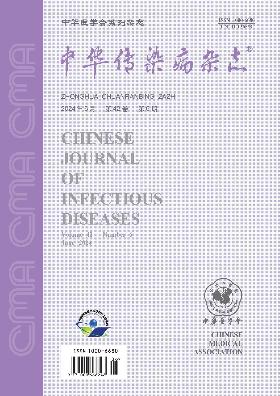天津市2015-2017年腹泻患者病原谱及流行病学特征分析
引用次数: 0
摘要
目的了解天津市急性腹泻患者的病原谱及流行病学特征。方法收集2015 - 2017年医院腹泻患者粪便标本1 536份。实时聚合酶链反应检测病毒核酸。采用选择性培养基培养细菌。药敏试验采用临床实验室标准化协会推荐的Kirby-Bauer圆盘扩散法。采用χ2检验进行统计学分析。结果1 536例腹泻患者的粪便标本中,检出1种肠道细菌109例,阳性率为7.10%;检出1种肠道病毒171例,阳性率为11.13%;检出混合感染20例,阳性率为1.30%,其中混合感染8例,双感染12例。腹泻病例总检出率为19.53%。诺如病毒、副溶血性弧菌、轮状病毒、沙门菌、星状病毒和萨帕病毒检出率居前6位。细菌总检出率曲线为单峰,主要出现在8月;病毒总检出率曲线为双峰,主要出现在5 - 6月和11 - 12月。30岁以上患者细菌阳性率为9.82%(75/764),30岁以下患者细菌阳性率为5.44%(42/772)。差异有统计学意义(χ2=10.451, P<0.01)。年龄不小于25岁的患者病毒病原体阳性率为10.02%(91/908),年龄小于25岁的患者病毒病原体阳性率为17.83%(112/628)。差异有统计学意义(χ2=19.755, P<0.01)。沙门氏菌、志贺氏菌和副溶血性弧菌对氨苄西林均有不同程度的耐药。结论细菌和病毒的阳性率曲线存在明显差异,呈“细菌单峰、病毒双峰”的趋势。细菌主要感染30岁以上人群,而病毒主要感染25岁以下人群。腹泻的主要病原体为诺如病毒、副溶血性弧菌和轮状病毒。关键词:腹泻;人口监测;病原谱本文章由计算机程序翻译,如有差异,请以英文原文为准。
Pathogenic spectrum and epidemiological characteristics of diarrhea patients in Tianjin during 2015-2017
Objective
To investigate the pathogenic spectrum and epidemiological characteristics of acute diarrhea patients in Tianjin.
Methods
A total of 1 536 stool samples of diarrhea patients were collected from hospitals between 2015 and 2017. Viral nucleic acids were detected by real-time polymerase chain reaction. Selective medium was used to culture bacteria. Drug susceptibility tests were performed by Kirby-Bauer disk diffusion method recommended by the Association for Standardization of Clinical Laboratories. χ2 test was used for statistical analysis.
Results
In the stool samples of 1 536 cases of diarrhea, one enteric bacterium was detected in 109 samples with the positive rate of 7.10%, one enterovirus was detected in 171 samples with the positive rate of 11.13%, mixed infection was detected in 20 samples with positive rate of 1.30%, including 8 samples with enteric bacterium and enterovirus and 12 samples with double enterovirus. The total detection rate of diarrhea cases was 19.53%. Norovirus, vibrio parahaemolyticus, rotavirus, Salmonella, stellate virus and sapovirus ranked the top six in the detection rate. The total detection rate curve of bacteria showed a single peak, mainly in August, while the total detection rate curve of the virus showed a double peak, which was from May to June and from November to December. The positive rate of bacteria in patients aged over 30 years old was 9.82% (75/764), while that in those aged less than 30 years old was 5.44% (42/772). The difference was statistically significant (χ2=10.451, P<0.01). The positive rate of viral pathogen in patients aged no less than 25 years old was 10.02% (91/908), while that in those aged less than 25 years old was 17.83% (112/628). The difference was statistically significant (χ2=19.755, P<0.01). Salmonella, Shigella and vibrio parahaemolyticus were resistant to ampicillin in varying degrees.
Conclusions
The positive rate curves of bacteria and virus are obviously different, showing a trend of "bacterial single peak and viral double peak" . Bacteria mainly infect people aged over 30 years old, while the virus mainly infects people under 25 years old. The main pathogens of diarrhea are norovirus, vibrio parahaemolyticus and rotavirus.
Key words:
Diarrhea; Population surveillance; Pathogen spectrum
求助全文
通过发布文献求助,成功后即可免费获取论文全文。
去求助
来源期刊
自引率
0.00%
发文量
5280
期刊介绍:
The Chinese Journal of Infectious Diseases was founded in February 1983. It is an academic journal on infectious diseases supervised by the China Association for Science and Technology, sponsored by the Chinese Medical Association, and hosted by the Shanghai Medical Association. The journal targets infectious disease physicians as its main readers, taking into account physicians of other interdisciplinary disciplines, and timely reports on leading scientific research results and clinical diagnosis and treatment experience in the field of infectious diseases, as well as basic theoretical research that has a guiding role in the clinical practice of infectious diseases and is closely integrated with the actual clinical practice of infectious diseases. Columns include reviews (including editor-in-chief reviews), expert lectures, consensus and guidelines (including interpretations), monographs, short monographs, academic debates, epidemic news, international dynamics, case reports, reviews, lectures, meeting minutes, etc.

 求助内容:
求助内容: 应助结果提醒方式:
应助结果提醒方式:


